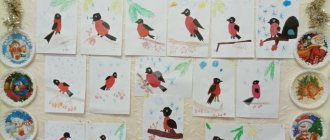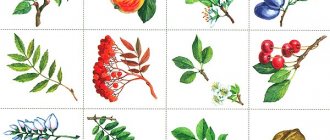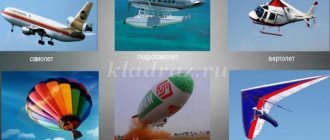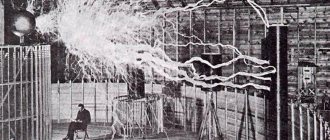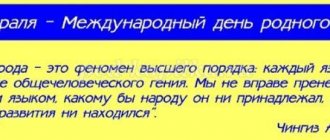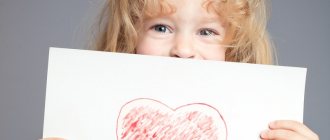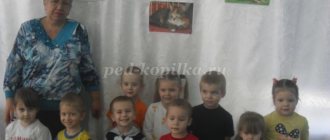Summary of a lesson on cognitive development in the preparatory school group “Red Book”
Summary of a lesson on cognitive development in the preparatory school group “Red Book”
Educational field: Cognitive development
Type of GCD: introduction to the natural world.
Goal: To consolidate the belief about the pricelessness of nature and bring to the conclusion about the need to protect birds.
Tasks:
Educational: to cultivate a sense of responsibility for one’s behavior in the natural world, the skills of caring for animals and plants; evoke an emotional response. Cultivate kindness, responsiveness, and love of nature.
Developmental: instill feelings of empathy for the problems of the surrounding nature; encourage them to be active conservationists; develop an understanding of the importance of the role of animals and plants in human life, develop logical thinking, attention, observation, curiosity; increase children's speech activity, mental activity, and develop the ability to answer questions.
Educational:
Teach rules of behavior in nature; understand the connections that exist in nature, clarify the role of humans in the life of birds; list protected birds listed in the Red Book; enrichment and activation of vocabulary on the topic.
Equipment: multimedia projector, containers for oil and water, fur, brushes, napkin, oilcloth, gel ball, needle, flower.
Progress of direct educational activities.
1. Organizational moment. (in a circle)
All the children gathered in a circle.
I am your friend and you are my friend.
Let's hold hands tightly
And let's smile at each other.
Educator: - I’ll look at your faces, who should I make friends with here?
Educator: Today we will go on an exciting journey into the mysterious world of nature, learn about the existence of an unusual book and what it is needed for.
Please look at the screen. What is this? (children's answers).
-That's right, the Red Book. Who knows what kind of book this is? (children's answers)
— Among the birds, animals, insects, trees and flowers, there are some of which there are very few left. They are called rare or endangered. Why do you think they have become rare? (children's answers)
— Rare animals and plants in our country and in our district are protected by law. But unkind people often break this law. Man is often very cruel to plants and animals. Very often people do not spare them and destroy them for their own purposes. Some suffer because of beautiful fur, others because of tasty meat, and others because people are afraid of them. Gradually, there are fewer and fewer plants and animals left. And then people started thinking about how to stop the disappearance of animals. So we decided to create a Red Book. Why Red and not some other color?
Project in the senior group “Opening the Red Book of Russia”
Objective of the project:
introduce children to the Red Book of Animals of the Russian Federation and species of rare (endangered) animals; with the concepts of “habitat”, “food chain”, with the work of zoos and reserves to preserve rare species of animals; to give an idea that nature is a single living organism in which all animals and plants are important (there are no good or bad ones); to cultivate a caring attitude towards nature: nature is diverse, but fragile and not limitless, it must be protected and preserved.
Lesson No. 1 “Opening the Red Book.”
Objectives: familiarization with the Red Book, the concept of “rare animal”.
View the presentation “Animals from the Red Book”.
During the lesson, the guys and I watched the presentation and had a conversation. The children were surprised at how many animals they know were included in the Red Book. The term “rare animal” was explained. The children were asked a problematic question: why are there fewer animals? (Animals have little food, animals have nowhere to live, animals are hunted). At the end of the lesson, the conclusion was made that rare animals need to be saved.
In the evening, watch the cartoon “The Red Book” (animated series “Smeshariki”).
Lesson No. 2 “Habitat”.
Objectives: familiarization with the concept of “habitat”, what it is; explain why animals live only in certain habitats, why habitats disappear, how people can help animals survive.
View the presentation "Habitat".
During the lesson, while showing the presentation, the term “habitat” (the place where the animal lives, hunts, and breeds) was explained to the children. The habitat may disappear, then the animals have nowhere to live and nothing to eat. Habitats can disappear due to natural disasters (for example, a forest fire) or due to destructive human activities (air and water pollution; deforestation and construction of houses and roads in their place). Conclusion: the habitat of animals must be treated with care: assess the harm and benefits that a change in the habitat can bring.
In the second part of the lesson, children were shown pictures with various habitats: forest, swamp, sea, field, tundra (permafrost), etc. After this, the game “Who lives where?” was played.
Pictures with different animal habitats were displayed on the board, and the child had to “place” the animal from the pictures in its habitat.
Conducting the didactic game “Who Lives Where?” (meadow-butterfly, Arctic - walrus, swamp - heron, forest - badger).
Lesson No. 3 “Food chains”.
Objectives: to introduce children to the concepts of “predatory animal”, “herbivore”, explain the relationship between predatory and herbivorous animals, mutual benefit; explain the concept of “food chain”; During the game, bring the children to the conclusion that if one of the links in the food chain disappears, then the whole chain is destroyed.
View the presentation “Carnivorous and herbivorous animals. Food chains".
While watching the presentation, it was explained to the children that predatory and herbivorous animals can be distinguished by their teeth: a predatory animal has sharp teeth (fangs), since they need to hunt, while herbivores have blunt teeth, they use them to chew grass, bark, and leaves. Herbivores are food for carnivorous animals. But in nature there are no “bad” and “good”, “evil” and “good” animals, they all bring benefits. Herbivores promote plant growth, while carnivores hunt primarily old and weak animals, helping the strong and healthy to survive. Plants, herbivores and carnivorous animals are combined into a food chain: plants are food for herbivores, herbivores are food for predators.
In the second half of the lesson, the game “Make a food chain” was played. Children were given pictures on their tables with paper clips (chain links) attached to them. The children had to determine who was eating what (whom) and connect the chain correctly. After making the chains, the children, at the request of the teacher, covered one of the animal pictures with their hand and explained what would happen if one or another animal disappeared (if there were no mosquitoes, the frogs would starve, etc.). In this way, children were led to the idea that there are no “extra” or “bad” animals in nature. They are all important and they all bring some benefit to each other.
At the end of the lesson, the children were offered models to represent carnivorous (a triangle in a circle - a sharp tooth) and herbivores (a rectangle in a circle - a blunt tooth) animals.
Food chains collected by children.
Lesson No. 4 “How people save rare animals.”
Objective: to give children an idea of working in zoos and reserves to preserve rare species of animals; concepts of “reserve”, “bird ringing”, “animal capture”.
View the presentation “How people save rare animals.”
While watching the presentation, the children were told about the work of people in zoos and nature reserves. The zoo breeds animals in captivity. They can no longer be returned to the wild, but they can survive near people. A reserve is a huge area of wild nature where any human activity to change it is prohibited (deforestation, drainage of swamps, construction of houses, etc.). In nature reserves, scientists study wild animals and help them survive (they count the animals, feed them in winter, and make sure that the animals do not get sick). When there are many animals in the reserve, they are caught and transported to another reserve, where there are few such animals. Scientists ring birds to track where these birds fly in winter and where they bear offspring. Then the children were explained the rules of behavior in the zoo (do not feed the animals, do not knock on the glass, do not make noise) and in the reserve (you cannot tear plants, you must walk along the paths, you must not make noise, etc.).
At the end of the lesson, the children were shown models that will indicate in Our Red Book: “you cannot hunt,” “the animal is protected in the reserve.”
Throughout the project, in the evenings there was a screening of the BBC documentary “Climate Zones of the Earth. Habitat".
The knowledge acquired by children in classes to familiarize themselves with the world around them was supported in classes on productive activities.
Application – “Polar bears on an ice floe”.
Construction – “We are building a zoo.”
Modeling - “My favorite animal from the Red Book.”
The result of the project activity is the creation of the Red Book of Animals for the group.
Goal: to create a manual that children and group teachers could use.
In order for children to be able to “read” the book on their own, a modeling method was used. All models were explained to the children during the entire project in class. For educators, a page with the necessary material has been made about each animal.
Children “read” Our Red Book.
Authors: Botkina Svetlana Sergeevna,
Klyagina Daria Borisovna,
teachers of GBOU secondary school No. 349 in Moscow
(preschool department No. 1205)
The article is published in the author's edition
Lesson summary on the world around us on the topic “The Red Book”
Message – “From the history of the creation of the Red Book.”— Guys, which of you held the Red Book in your hands?
-Who knows what the Red Book is?
— Where did you meet the color red?
-Remember what the red traffic light shows? (Alert.)
-That's right, the red traffic light warns: “Caution! Trouble might happen"
-Why is this book called that?
-This book is called so because the color red, with its brightness, makes everyone pay attention to the danger; in this case, it warns people about the possible dire consequences that will occur with the death of entire species of plants and animals.
– Why do you think certain plants and animals were included in the Red Book?
The development of new territories by people, plowing of land, deforestation, construction of factories, thoughtless hunting and extermination of animals have led to the fact that many species of plants and animals have already disappeared from the face of the Earth. Some species of animals were quite numerous in the past, but man destroyed them. For example, hunting whales solely for their fat almost led to their extinction. Many animals and plants are in great danger of simply disappearing from the face of the Earth.
By destroying nature, a person himself can suffer. To prevent this from happening, scientists compiled a special book - the Red Book.
In 1948, the International Union for Conservation of Nature was created. Scientists from different countries compiled lists of endangered animals and plants and in 1963 published the International Red Book; it contains all data on plants and animals that urgently need protection.
"Through the pages of the Red Book"
The pages of the Red Book are multi-colored.
-Why do you think?
This is not for decoration. By the color of the page you can determine in what position a particular plant or animal is located. Now we will work in groups and create color pages of the red book. But first, let's remember the rule of working in groups. (Each group is given 2 sheets of colored cardboard with the names and outlines of animals and two sets of cut animals).
Black pages
contain lists of those who are no longer there, whom we will never see again, who have already died out (Sea cow, passenger pigeons, dodo.).
About 250 years ago, Bering's expedition discovered in the sea, near the shore, unprecedented animals that grazed peacefully in the thickets of seaweed. They were called sea cows. These trusting, slow animals the size of an elephant were not afraid of people and swam close to their boats. And people killed them mercilessly. Every year there were fewer and fewer of them, and after 27 years they were all exterminated. So the sea cows disappeared forever. Now no one, anywhere, will ever see these wonderful animals.
Red pages
show us endangered and especially rare animals (red wolf, snow leopard, Amur tiger and others).
Yellow Pages
– those animals whose number is rapidly decreasing (polar bears, pink flamingos, bustards, black storks and others, such plants as the swimsuit, tulip, hazel grouse).
White pages
- these are the animals that have always been in short supply.
Gray Pages
– those animals that have been studied very little and their habitats are inaccessible are included (elephant tortoise, mountain gorilla)
Green Pages
– those animals that we managed to preserve and save them from extinction (elk, brown bear, river beaver, black-footed ferret).
